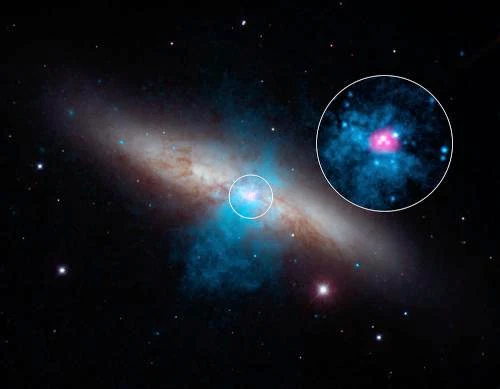High-energy X-rays streaming from a rare and mighty pulsar (magenta), the brightest found to date, can be seen in this new image combin...
 |
| High-energy X-rays streaming from a rare and mighty pulsar (magenta), the brightest found to date, can be seen in this new image combining multi-wavelength data from three telescopes. The bulk of a galaxy called Messier 82 (M82), or the 'Cigar galaxy,' is seen in visible-light data captured by the National Optical Astronomy Observatory's 2.1-meter telescope at Kitt Peak in Arizona. Starlight is white, and lanes of dust appear brown. Low-energy X-ray data from NASA's Chandra X-ray Observatory are colored blue, and higher-energy X-ray data from NuSTAR are pink. Credit: NASA/JPL-Caltech/SAO/NOAO
Astronomers working with NASA's Nuclear Spectroscopic Telescope Array (NuSTAR), led by Caltech's Fiona Harrison, have found a pulsating dead star beaming with the energy of about 10 million suns. The object, previously thought to be a black hole because it is so powerful, is in fact a pulsar—the incredibly dense rotating remains of a star.
"This compact little stellar remnant is a real powerhouse. We've never seen anything quite like it," says Harrison, NuSTAR's principal investigator and the Benjamin M. Rosen Professor of Physics at Caltech. "We all thought an object with that much energy had to be a black hole."
Dom Walton, a postdoctoral scholar at Caltech who works with NuSTAR data, says that with its extreme energy, this pulsar takes the top prize in the weirdness category. Pulsars are typically between one and two times the mass of the sun. This new pulsar presumably falls in that same range but shines about 100 times brighter than theory suggests something of its mass should be able to.
"We've never seen a pulsar even close to being this bright," Walton says. "Honestly, we don't know how this happens, and theorists will be chewing on it for a long time." Besides being weird, the finding will help scientists better understand a class of very bright X-ray sources, called ultraluminous X-ray sources (ULXs).
Harrison, Walton, and their colleagues describe NuSTAR's detection of this first ultraluminous pulsar in a paper that appears in the current issue of Nature.
Read More>> |


No comments